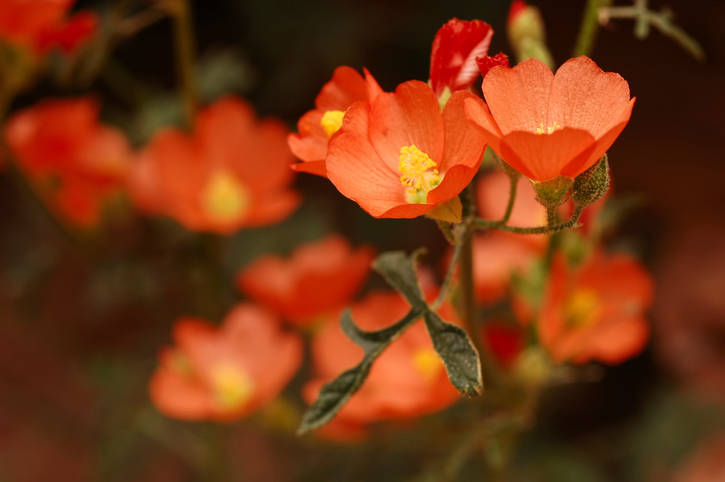
As much as I look forward to spring and the frenzy of planting out my garden, spring also brings weeds. They begin to appear around the same time that my first seedlings are starting to sprout.
While it is easy to see weeds as a problem, and most people do, I prefer to look at what they offer and ways that they can benefit my garden. A weed is simply a plant growing where it is not wanted. They are often native to where they grow and can be very beautiful.
The beauties:
Orange globe mallow: One of my favorite flowers to see in the spring is the orange globe mallow. Its delicate orange blossoms remind me of poppies, which take a lot more work to grow in our climate. I find them popping up from time to time under my mesquite trees and they come back year after year.
Sacred Datura: Another weed with beautiful flowers is called the Sacred Datura. It is also known as Jimson weed. You see it most often near ditches along the sides of the road around town. It’s trumpet-shaped white flowers seem to open in the morning and close tight during the hotter parts of the day. Datura is in the nightshade family. Tomatoes are also another member of the nightshade family.
If you plant Datura on the outskirts of your vegetable garden, the tomato hornworm will be attracted to them first. They make a great trap crop and will help to keep the hornworms out of your vegetables. Check the Datura in morning and evening to spot the hornworms. They blend in well, so look for their telltale black droppings on leaves.
Purslane: Purslane is an edible weed that pops up in late spring and early summer. I find it most often in the unamended soil surrounding my flower beds. Its creeping leaves sprawl delicately across the ground and are reminiscent of succulents. They taste great when picked fresh and added to salad. Pull the tiny leaves from their vine for the best flavor. Chickens like purslane too. Purslane will die back when the heat of summer sets in.
London Rocket: London rocket, also called rocket mustard, is another edible weed. It grows to about 3 feet tall in areas where water collects, such as the sides of buildings. It’s small yellow flowers are often confused with dandelion when the plants are not very tall. The young leaves have a spicy flavor similar to arugula.
The beasts:
Russian Thistle: One of the most iconic weeds of the American West hails from Russia. The Russian thistle, also known as tumbleweed, is a nuisance that we endure every fall and winter as it blows down our streets and across our yards. In the spring it is often mistaken for tiny sprouting pine trees. Tumbleweed does not have much use to me but there is a gentleman in Utah who makes a living from selling them to Europeans.
Puncturevine: Puncturevine, also known as goathead, can be easily mistaken for purslane at a distance. It is a low sprawling plant that bear tiny yellow flowers and vines with delicate looking leaves. Unlike purslane, puncturevine can be toxic to livestock. When it goes to seed, it produces spiny burs that are easily blown around by the wind. They are very painful when stepped on and can even puncture tires.
Foxtail grass: Foxtail grass spreads rapidly and is extremely invasive. It grows in clusters and has a similar appearance to a field of barley. Foxtail looks harmless but is perhaps the most damaging of the weeds on this list. Foxtail awnings can become lodged under the skin, often in dogs. If not removed, they can work their way into the body, causing irreversible damage and infection. Check your dog over regularly for abscesses, which is a sign that they may have foxtail lodged under their skin.
When dealing with weeds in your landscape, whether beauties or beasts, the surest way to remove them is to pull them. Preventing the weeds from growing in the first place is even better. In my raised bed vegetable garden, I apply a thick layer of straw mulch and rarely encounter weeds.
Part of my routine before I head to work in the morning is walking my yard to check for weeds. I pull them as I see them. Most of my acreage is covered in landscape gravel. I’m not a big fan of it but it does make it harder for the weeds to take root and as a result they are not hard to pull out.
I try my best to pull the weeds before they form flowers. I look at them as free compost which didn’t cost me any water. Weeds pull up minerals from the soil that break down over time in the compost pile and can enrich your vegetable garden. Weed pulling can become time-consuming in the spring, but on the bright side, it’s great exercise and cheaper than the gym.
Terri Meehan is the Founder of Southern Nevada Gardening Association a regional group. She is a garden mentor and local farmer in Pahrump. Send questions or comments to her at sonvgarden@gmail.com